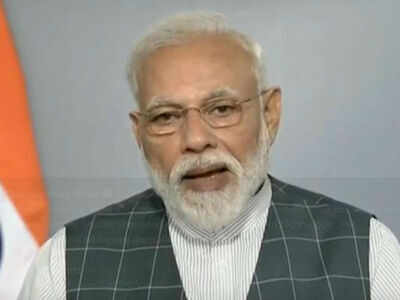- News
- India News
- India joins super space club with launch of anti-satellite missile
Trending
This story is from March 27, 2019
India joins super space club with launch of anti-satellite missile

NEW DELHI: In a historic day for the country, India on Wednesday entered the elite space club and became the fourth country in the world after the US, Russia and China to develop the technology to launch an anti-satellite (ASAT) missile or weapon.
Breaking news of Defence Research and Development Organisation-led historic launch, Prime Minister Narendra Modi in an unprecedented broadcast to the nation at 12.30 pm, his second after the announcement of demonetisation on November 8, 2016, said, "A few hours ago, a low-earth orbit (LEO) satellite was destroyed by an ASAT missile within three minutes of the launch.The launch under Mission Shakti has put our country in a space super league." The PM clarified that the action was not against any country and that the satellite was a pre-determined target orbiting at an altitude of 300 km. He also clarified that the launch does not breach any international laws or treaties.While congratulating all DRDO scientists for the rare feat, Modi said the entire effort was "indigenous that will make India stronger, even more secure and will further peace and harmony".
Though Indian Space Research Organisation (Isro) was not directly involved in Wednesday's launch, the target used for the mission was a 740kg Microsat-R DRDO-developed satellite that was recently launched by the space agency on January 24 this year. Microsat-R was considered to be a military surveillance satellite with capability to capture images at night. However, today's launch cleared the DRDO's real motive to launch Microsat-R.
Explaining the significance of the launch, former DRDO scientist Ravi Gupta said, "Today's launch gives India a quantum jump in ASAT technology development. To develop the technology, a country needs a tracking system, a platform to take the warhead to the target, a navigation system and a warhead to destroy the target."
Ravi Gupta said, "Any hostile or rogue satellite which is considered a threat to our national interest can now be shot down with the AST missile."
"The missile targeted the satellite at 300km altitude because most of the spy or military satellites of different countries are placed in the low-earth orbit from 300km-700km. Placing them in the LEO orbit helped in better surveillance," he said.
While the US and Russia had developed the ASAT missile technology during the Cold War era and had been finetuning it since then, China conducted the first successful AST missile test on January 11, 2007 when it used its weather satellite as the target.
ASAT missiles have not been used in any warfare till now. However, some of these countries had used the technology to kill their defunct satellites.
Breaking news of Defence Research and Development Organisation-led historic launch, Prime Minister Narendra Modi in an unprecedented broadcast to the nation at 12.30 pm, his second after the announcement of demonetisation on November 8, 2016, said, "A few hours ago, a low-earth orbit (LEO) satellite was destroyed by an ASAT missile within three minutes of the launch.The launch under Mission Shakti has put our country in a space super league." The PM clarified that the action was not against any country and that the satellite was a pre-determined target orbiting at an altitude of 300 km. He also clarified that the launch does not breach any international laws or treaties.While congratulating all DRDO scientists for the rare feat, Modi said the entire effort was "indigenous that will make India stronger, even more secure and will further peace and harmony".
Though Indian Space Research Organisation (Isro) was not directly involved in Wednesday's launch, the target used for the mission was a 740kg Microsat-R DRDO-developed satellite that was recently launched by the space agency on January 24 this year. Microsat-R was considered to be a military surveillance satellite with capability to capture images at night. However, today's launch cleared the DRDO's real motive to launch Microsat-R.
Explaining the significance of the launch, former DRDO scientist Ravi Gupta said, "Today's launch gives India a quantum jump in ASAT technology development. To develop the technology, a country needs a tracking system, a platform to take the warhead to the target, a navigation system and a warhead to destroy the target."
The DRDO veteran said, "We had individual technology capabilities. What was needed a coordinated effort to put these technologies together to perform a specific task in a modest way and at a low cost. For example, we have developed a wide array of missiles with different ranges like Prithvi and Agni versions, navigation system like NaVIC and different war heads, even nuclear warheads. Finally, Mission Shakti showed our capabilities to deliver ASAT."
Ravi Gupta said, "Any hostile or rogue satellite which is considered a threat to our national interest can now be shot down with the AST missile."
"The missile targeted the satellite at 300km altitude because most of the spy or military satellites of different countries are placed in the low-earth orbit from 300km-700km. Placing them in the LEO orbit helped in better surveillance," he said.
While the US and Russia had developed the ASAT missile technology during the Cold War era and had been finetuning it since then, China conducted the first successful AST missile test on January 11, 2007 when it used its weather satellite as the target.
ASAT missiles have not been used in any warfare till now. However, some of these countries had used the technology to kill their defunct satellites.
End of Article
FOLLOW US ON SOCIAL MEDIA










